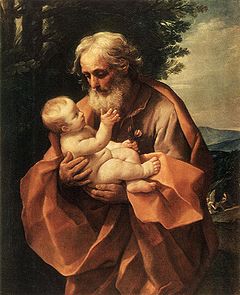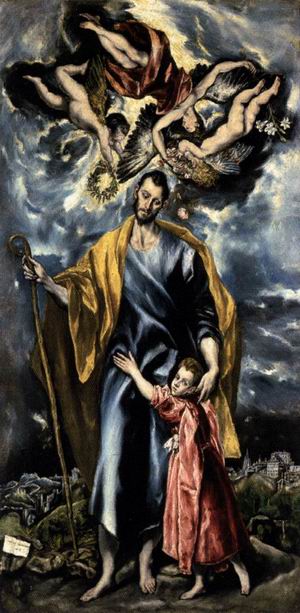|
St. Joseph’s Day—the original Father’s Day
Carol Iannone writes:
March 19 is the Feast of St. Joseph. St. Joseph’s Day is Father’s Day in some countries, including Italy, Spain, and Portugal. Rightly so, because at God’s direction he willingly cared for and protected Mary and her baby and served as Jesus’ human father throughout his childhood to make the holy family complete on earth. He is a powerful symbol of the importance of husbands and fathers, and men in general, in families and in the lives of women and children. Although some artists depicted Joseph as a feeble old man (to emphasize Mary’s virgin pregnancy), this is really in violation of what is clearly presented in the Gospels of his vigor, strength, and spirit. Fortunately, some artists did him justice.
The painting below by Guido Reni shows Joseph as older but at least as still vital, alert, and attentive:
 The below painting by El Greco portrays Joseph as a still young and watchful father, with Jesus as his loving little boy:
The below painting by El Greco portrays Joseph as a still young and watchful father, with Jesus as his loving little boy:
 It is interesting that in both paintings Jesus, too, though still a baby or a little boy, is portrayed as responding directly to Joseph and, in a way, reassuring and protecting him as well.
It is interesting that in both paintings Jesus, too, though still a baby or a little boy, is portrayed as responding directly to Joseph and, in a way, reassuring and protecting him as well.
St. Joseph is also the patron saint of pastry chefs, and there is a special pastry connected to St. Joseph, with cream and cherries, pictured below.

LA writes:
That’s great how in both the Reni painting and the El Greco painting, as Miss Iannone points out, the little Jesus is watching over and protecting Joseph, even as Joseph is watching over and protecting Jesus.
In connection with Joseph and his role in the Christian revelation, see also the entry I wrote last December about the significance of Joseph’s assent to the divine calling as told in the first chapter of the Gospel of Matthew:
When the angel tells him that the child in her was conceived by the Holy Spirit, and that it is destined to be a savior to mankind, Joseph, instead of saying, “This is ridiculous,” believes it. He accepts the angel’s impossible statement about the nature of Mary’s pregnancy, and he obeys the angel’s call for him, Joseph, to take Mary as his wife. By doing these things, he accepts the revelation of a non-material, divine reality, and his own mission and role as the adoptive father of the savior….
Now what occurred to me when I read the story of Joseph is that Joseph, by his act of faith in something that defied all material knowledge, and by his consent to a divine mission, is as much the perfect believer as Mary is. It is through Joseph’s perfect faith in God, his recognition and embrace of a higher reality, as much as through Mary’s, that Christ’s advent occurred in the way it did, and that the Christian religion was born.
- end of initial entry -
Vincent Chiarello writes:
Molte grazie.
Interestingly enough, the day is more known and celebrated in Sicily than in the rest of Italy. And there is also an unquestionable religious aspect to the holiday: the building in individual home of a (temporary) altar, blessed by a priest, to St. Joseph, something not known to me growing up in New York, but far more common amongst the Italian-Americans of Sicilian background who reside in Louisiana. Why? I haven’t a clue.
In Rome and other parts of Italy, it is still a tradition that during this week, the pasticceria (bakeries) will feature a delight called bigni di San Guiseppe, what we would generally call a creampuff, filled with the most delicious cream I’ve ever tasted.
In a short while, we’re off to celebrate, altar and all, il festaggio di San Giuseppe at the home of one of our parishioners. As the only (half) Sicilian who will be present, my duty was to bring the caponata (primarily eggplant arrayed with tomatoes and onions) and the wine. What else but Nero d’Avola, the favored nectar of the gods from Sicily?
Carol Iannone replies:
In my Neapolitan American home, it was also celebrated. Someone would always bring home those pastries.
Kidist Paulos Asrat writes:
I didn’t know today is St. Joseph’s day.
On December 2007, around Christmas time, I did a blog post on several images I had found of St. Joseph with Christ as an infant or a young child.
About three years later, I re-posted the blog, also around Christmas time, writing:
As we near Christmas, and we hear the lovely stories of Jesus’s birth and his young mother Mary, I always feel that we keep his earthly father, Joseph, a little on the side-lines.
Each time, I was struck by the gentleness with which Joseph interacted with Jesus.
In my 2010 post post I wrote:
The Joseph in Enrico Reffo’s painting appears the oldest. But, perhaps that is true to the reality. Joseph was quite likely a mature man when he married Mary, who was half his age. Perhaps that is where his gentleness came from, entrusted as he was with a baby in his mature years. But, I don’t think God would have given Jesus a harsh father. Joseph’s gentleness is part of the beautiful design.
LA replies:
I don’t see any basis in the Gospels to believe that Joseph was middle aged or old when he married Mary. Clearly the tradition of portraying him as an older man stems from the Catholic belief that the marriage of Mary and Joseph was celibate. The Gospels clearly contradict this, right there in Matthew chapter one:
Then Joseph being raised from sleep did as the angel of the Lord had bidden him, and took unto him his wife: And knew her not till she had brought forth her firstborn son: and he called his name JESUS.
So after Mary gave birth to Jesus, Joseph knew her, meaning he had sexual relations with her.
Now look at Mark 6:3:
Is not this the carpenter, the son of Mary, the brother of James, and Joses, and of Juda, and Simon? and are not his sisters here with us? And they were offended at him.
So according to Mark, Jesus had four brothers and at least two sisters.
And here’s Mark 3:31-35:
There came then his brethren and his mother, and, standing without, sent unto him, calling him. And the multitude sat about him, and they said unto him, Behold, thy mother and thy brethren without seek for thee. And he answered them, saying, Who is my mother, or my brethren? And he looked round about on them which sat about him, and said, Behold my mother and my brethren! For whosoever shall do the will of God, the same is my brother, and my sister, and mother.
Now let’s not get into the discussion that “brothers” and “sisters” really means cousins. If it had been Jesus’ cousins and his mother standing outside and wanting to see him, Jesus couldn’t have made the statement about who are his mother and his brethren, or rather its meaning would have been transformed. If brethren in this scene refers to cousins or relatives, his ringing declaration would have meant, “Whosoever shall do the will of God, the same is my male cousin, and my female cousin, and my mother,” which would have sounded ridiculous and would have lost all its force. The only way the scene makes sense is that Jesus had brothers, the sons of his mother and his father, and he is inviting his followers to become his spiritual brothers—not his spiritual cousins, which, again, would be absurd.
Posted March 23
Joseph A. writes:
You have certainly invited commentary from your Catholic readers with your dismissal of the Theotokos’ ever-virginity. This topic has been debated for centuries, and there is nothing that I can add to change anyone’s mind. I just wanted to state that according to the tradition in the East, the “brothers of the Lord”—James the Just, Jude, Justus, Simon—are Joseph’s children from his first wife, Salome. Joseph and Salome also had a daughter named Salome, who is the wife of Zebedee and the mother of James the Great and John, which makes James and John the Lord’s nephews. In the iconographic tradition, Joseph is thus depicted as an older man, though certainly not a frail or weak man. He was, after all, the model of manly behavior for Jesus. In the Orthodox Church, we celebrate Joseph on the second Sunday before Christmas (when we remember all of the ancestors of Christ) and on the first Sunday after Christmas.
(My patron saint is Joseph of Arimathea, not Joseph the Betrothed, though he would be a wonderful patron, too)
DD writes:
Your interpretation of the passage in Matthew is wrong. The text you quote does not support your idea that Jesus had biological brothers and sisters. There is a note in the Douay-Rheims Bible that gives an explanation:
Till she brought forth her firstborn son … From these words Helvidius and other heretics most impiously inferred that the blessed Virgin Mary had other children besides Christ; but St. Jerome shows, by divers examples, that this expression of the Evangelist was a manner of speaking usual among the Hebrews, to denote by the word until, only what is done, without any regard to the future. Thus it is said, Genesis 8:6 and 8:7, that Noe sent forth a raven, which went forth, and did not return till the waters were dried up on the earth. That is, did not return any more. Also Isaias 46:4, God says: I am till you grow old. Who dare infer that God should then cease to be: Also in the 1 Maccabees 5:54, And they went up to mount Sion with joy and gladness, and offered holocausts, because not one of them was slain till they had returned in peace. That is, not one was slain before or after they had returned. God saith to his divine Son: Sit on my right hand till I make thy enemies thy footstool. Shall he sit no longer after his enemies are subdued? Yea and for all eternity. St. Jerome also proves by Scripture examples, that an only begotten son, was also called firstborn, or first begotten: because according to the law, the firstborn males were to be consecrated to God; Sanctify unto me, saith the Lord, every firstborn that opens the womb among the children of Israel, etc. Exodus 13:2. (Challoner)
If your comment was true, it would also disprove another traditionally held belief (and Church Dogma) concerning the virginity of Mary.
Vincent Chiarello writes:
Our St. Joseph’s Day outing was delightful, aided and abetted by lovely weather and valiant attempts to duplicate Sicilian culinary delights by people who have never heard of Bigni di San Giuseppe. An “A” for effort, however. Being wise, my gift was definitely a Sicilian product—wine, and Nero d’Avola at that.
I enclose the Litany of St. Joseph that is said during the Mass on this day. I thought you might find it of interest, because as Larry—and others—have pointed out, St. Joseph rarely gets the attention he deserves. There is a small church near the Forum in Rome called San Giuseppe Falegname (St. Joseph the Carpenter) which I try to visit when in Rome.
At our gathering, one of our parishioners, whose parents are from the Piedmont in Italy, brought a book about the St. Joseph Altar, something constructed for this occasion. As I mentioned earlier, the entire book deals with the celebration of this festa in Louisiana in general, and New Orleans in particular. I do not ever recall of hearing of it while growing up in NY in the 40s and 50s.
Litany of St. Joseph
Lord, have mercy.
Christ, have mercy.
Lord, have mercy.
Christ, hear us.
Christ, graciously hear us.
God, the Father of Heaven, have mercy on us.
God the Son, Redeemer of the world, have mercy on us.
God the Holy Spirit, have mercy on us.
Holy Trinity, One God, have mercy on us..
Holy Mary, pray for us.
St. Joseph, pray for us.
Renowned offspring of David, pray for us.
Light of Patriarchs, pray for us.
Spouse of the Mother of God, pray for us.
Chaste guardian of the Virgin, pray for us.
Foster father of the Son of God, pray for us.
Diligent protector of Christ, pray for us.
Head of the Holy Family, pray for us.
Joseph most just, pray for us.
Joseph most chaste, pray for us.
Joseph most prudent, pray for us.
Joseph most strong, pray for us.
Joseph most obedient, pray for us.
Joseph most faithful, pray for us.
Mirror of patience, pray for us.
Lover of poverty, pray for us.
Model of artisans, pray for us.
Glory of home life, pray for us.
Guardian of virgins, pray for us.
Pillar of families, pray for us.
Solace of the wretched, pray for us.
Hope of the sick, pray for us.
Patron of the dying, pray for us.
Terror of demons, pray for us.
Protector of Holy Church, pray for us.
Lamb of God, who take away the sins of the world, spare us, O Lord!.
Lamb of God, who take away the sins of the world, graciously hear us, O Lord!.
Lamb of God, who take away the sins of the world, have mercy on us. .
V. He made him the lord of his household.
R. And prince over all his possessions.
Let us pray. O God, in your ineffable providence you were pleased to choose Blessed Joseph to be the spouse of your most holy Mother; grant, we beg you, that we may be worthy to have him for our intercessor in heaven whom on earth we venerate as our Protector: You who live and reign forever and ever. R. Amen.
Joseph C. writes:
As an American of Italian ancestry, I was thrilled to see the entry on Saint Joseph and the religious aspect of the holiday, some of which I learned of only recently. Being named Joseph, after my father and grandfather, the holiday was always celebrated in my family as well. My Father’s family was from Marche and my Mother’s family was from Napoli. And I have certainly enjoyed those pastries over the years—too many of them in fact. I would recommend one if you have a sweet tooth.
Posted by Lawrence Auster at March 19, 2011 11:14 AM | Send
|


